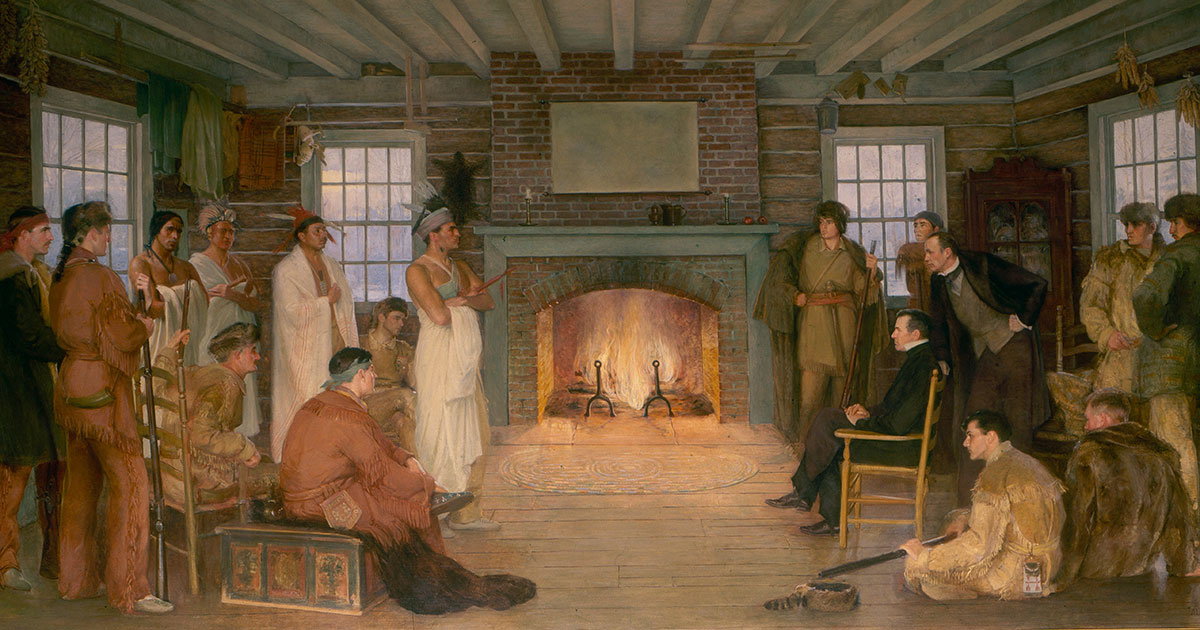
The 1830 trial of Chief Oshkosh is one of four murals in the Wisconsin Supreme Court chamber. Wisconsin Historical Society, Potter, James T., The Trial of Chief Oshkosh by Judge Doty, Image 45105 (painting, date unknown).
From the time it was a territory and before, there have been Native people living in what is now the state of Wisconsin. One of the earliest acknowledgements of that history is Albert Herter’s depiction of the 1830 trial of Chief Oshkosh, one of four murals in the Wisconsin Supreme Court chamber.
The mural recognizes the importance of territorial law in Wisconsin’s legal history. In that case, Judge James Doty dismissed murder charges against Chief Oshkosh because Doty recognized that neither the federal government nor the state had proper jurisdiction over Oshkosh and the subject matter. Although many things have changed in the last 195 years, all lawyers practicing in Wisconsin should have an elementary awareness and understanding of the sovereign Indian tribal governments and their members within the state.
Overview
Wisconsin has 11 federally recognized Indian tribes within its borders. These tribes vary in history, size, and location. More importantly for the purpose of this article, each has its own laws.1 Six of the tribes are bands of Lake Superior Ojibwe Indians: Bad River, Lac Courte Oreilles, Lac du Flambeau, Red Cliff, Sokaogon, and St. Croix. These six tribes plus the Potawatomi, Menominee, and Ho-Chunk are indigenous to Wisconsin. The Stockbridge-Munsee Tribe of Mohican Indians and the Oneidas came from the eastern U.S. in the mid-19th century. One tribe in Wisconsin, the Brothertown Indian Nation, continues to seek federal recognition. There are tribal members living in all 72 Wisconsin counties, with the highest numbers in Brown and Milwaukee counties.2
Indian tribes are unique legal entities. In a seminal case 200 years ago, the U.S. Supreme Court described them as “domestic dependent nations.”3 Each word bears on how tribes are treated today. The story of Indian law in the U.S. can be summarized as follows: Tribes were completely autonomous before European contact. Through case law and conquest, their autonomy has slowly eroded for the last several hundred years. Today, the competing interests of tribal, state, and federal authority evolve through the political and legal fields incrementally.
Indian tribal governments are not subject to the U.S. Constitution when dealing with their own tribal members.4 Each tribal government determines its own membership. Membership is usually set by tribal constitution or other law and often requires some biological connection to existing members.
Sovereign Immunity
Like other governmental entities, Indian tribes enjoy immunity from suit.5 Absent a waiver of immunity by the tribe itself or an abrogation of immunity by Congress, tribes cannot be sued.6 A waiver or an abrogation must be clear.7 The precise language needed for a waiver, whether in a contract or in a federal law, continues to be litigated.8
Wisconsin lawyers should know that when entering into a contract with an Indian tribe, like any other sovereign, the right to sue and the right to certain remedies may require special and different attention than when entering a contract with a nongovernmental commercial entity. Tribes rightfully guard their immunity carefully and vigilantly but also recognize the realities of commerce.
Editor’s Note: Tribal/Indian Law Special Focus Issue
Focusing on Indian and Tribal Law in Wisconsin

Sadie Cheyenne Wilson is an enrolled member of the Oneida Nation. She operates Sadie Cheyenne Photography. sadiecheyenne.com
With 11 federally recognized Indian tribes in Wisconsin (and one that is not recognized federally), Indian and tribal law is an important practice area for lawyers and judges in this state.
By Joe Forward
Understanding its importance as a practice area in Wisconsin, the State Bar of Wisconsin’s Communications Committee selected Indian and tribal law as the special focus for 2024.
This issue is primarily devoted to Indian and tribal law. To formulate the editorial plan, we enlisted the assistance of attorney Martina Gast as an advisor. Gast is the founder of Pipestone Law LLC, providing employment law and human resources support to Indian tribes and tribal entities. She is a member of the Red Rock Indian Band and was recently elected secretary of the State Bar of Wisconsin, taking office on July 1, 2024.
We thank Gast for helping us develop a comprehensive list of topics and finding a slate of excellent authors to navigate the complexities and intricacies of Indian and tribal law. Gast’s input and her collaborative approach helped us fill these pages with what we think are highly engaging articles.
We also thank the authors, members of the State Bar’s Indian Law Section, for contributing their time and expertise to this project. As you will see, all the authors have a deep understanding of Indian and tribal law and history, providing important perspectives as it relates to tribes and tribal members. We hope you find this special focus issue engaging and valuable as you navigate the legal world around you.
Finally, we thank Sadie Cheyenne Wilson, who provided some stunning photos of pow wows in Wisconsin. Wilson is a photographer, artist, and enrolled member of the Oneida Nation. She developed a passion for photography while attending U.W.-Green Bay.
Wilson describes herself as having a “passion for creating harmony amongst organic landscapes and subjects.” She started photographing pow wows in 2012 when she was tasked with photographing the Oneida Nation’s pow wow as an intern for Kalihwisaks, the Oneida Nation’s newspaper.
 Joe Forward, Saint Louis Univ. School of Law 2010, is communications director for the State Bar of Wisconsin, Madison. He can be reached by email or by phone at (608) 250-6161.
Joe Forward, Saint Louis Univ. School of Law 2010, is communications director for the State Bar of Wisconsin, Madison. He can be reached by email or by phone at (608) 250-6161.
Public Law 280
Ten of the 11 federally recognized tribes9 are subject to Public Law 83-280.10 Public Law 280, enacted in 1953, grants Wisconsin criminal jurisdiction on reservations as well as civil adjudicatory, but not regulatory, jurisdiction.
In plainer terms, the state of Wisconsin exercises full concurrent criminal jurisdiction on reservations but limited concurrent civil jurisdiction. The word “concurrent” is significant. Three courts have addressed the issue squarely and all agree that Public Law 280 did not divest tribes of concurrent criminal jurisdiction.11
Public Law 280 represented the U.S. government’s formal adoption of a policy of rapid assimilation of Native people through a policy called termination, referring to terminating the federal government’s government-to-government relationship with tribes.12 Although the termination era gave way to the era of self-determination in the early 1970s, Public Law 280 still applies to all Wisconsin tribes except the Menominee Indian Tribe.13
There are a few key points about application of Public Law 280 today of which all lawyers should be aware. District attorneys can charge individuals with crimes under state law regardless of where the crime occurred and regardless of the identity of the defendant (including status as a member of an Indian tribe) or the victim. Civil jurisdiction is more complicated and nuanced.
The U.S. Supreme Court decided that Public Law 280’s grant of civil jurisdiction was adjudicatory, not regulatory.14 Thus, tribal members (including those living on reservations) may bring civil suits (and be sued) in Wisconsin state courts. However, Wisconsin’s civil regulatory laws do not apply on reservations. As one might imagine, this has led to litigation over the years as to whether an area of regulation is civil regulatory – and thus inapplicable on the reservations – or whether it is criminal prohibitory and thus enforceable.
The answers have varied. Here are a few examples: uncased firearms – regulatory;15 third-offense operating after revocation and operating while intoxicated – prohibitory;16 fireworks – regulatory;17 extradition – prohibitory;18 and Wis. Stat. chapter 980 (sexually violent person commitments) – prohibitory.19
Tribal Courts
Another important consequence of concurrent jurisdiction is how the state and tribal courts decide where a case should be heard when it could be heard by either entity. The controlling law on this issue is Teague v. Bad River Band of Lake Superior Tribe of Chippewa Indians.20 In Teague, the Wisconsin Supreme Court ruled that circuit court judges must confer with their tribal counterparts when there is overlapping jurisdiction under Public Law 280. The circuit court must then apply comity in deciding where the action should be heard. The Teague ruling resulted in creation of administrative protocols in the judicial administrative districts in northern Wisconsin as well as a statute, Wis. Stat. section 801.54, which gives Wisconsin circuit court judges the discretion to transfer appropriate cases to tribal courts.
All 11 Wisconsin tribes have some form of a judicial branch. Like tribes themselves, the tribal courts vary in scope of subject-matter jurisdiction, requirements for practice, and whether judges are elected or appointed. While there are important differences between practicing in tribal and state courts, there are many similarities.
Just as state and local laws can vary by state, each tribe has its own laws, local rules, procedures, and personnel. Judges in tribal court worry about many of the same things that state court judges worry about: threats to judicial independence, managing difficult cases and resources, and efficiently and fairly adjudicating the cases that come before them.
The last 25 years have been something of a golden era of state-tribal judicial cooperation and communication, largely as a result of the issues and awareness raised in the Teague case. The cooperation and communication gained momentum when Wisconsin hosted a Walking on Common Ground conference in 2005, which brought together federal, state, and tribal judges to communicate and learn from each other.21 The Wisconsin Supreme Court justices meet regularly with their tribal counterparts. Circuit court judges and tribal court judges have many joint endeavors around the state.22 The State-Tribal Justice Forum is a standing entity, the members of which (tribal and state court judges) regularly meet.
Indian Child Welfare Act and Family Law
Legal matters involving children or families (for example, divorce) are those in which Wisconsin lawyers with general practices are most likely to encounter Indian law.
Indian Child Welfare Act. Under the federal and state versions of the Indian Child Welfare Act (ICWA),23 special rules apply when an Indian child is removed from the care of the child’s parents or caregivers. The purpose is to keep children attached to their tribal culture.
The law came into existence after it came to light that in the 1940s, 1950s, and 1960s, state social service agencies were removing Indian children from their homes and encouraging their adoption by people who are not Indians. The reasons ranged from ignorance of Indian ways (at best) to abuse of state power (at worst).24 Under ICWA and state equivalents, such as the Wisconsin Indian Child Welfare Act (WICWA) (codified in Wis. Stat. chapters 48 and 938), tribes have the right to intervene in children-in-need-of-protection-or-services (CHIPs) and termination-of-parental-rights (TPR) proceedings; seek transfer of these cases to their tribal court; and enforce application of placement preferences for foster care and adoptions, along with many other substantive and procedural requirements.
A lawyer who represents any party in a CHIPs, TPR, adoption, guardianship, or other proceeding in which an Indian child is placed out of the home must be certain about whether the child is either a member of or eligible for membership in a federally recognized Indian tribe. This threshold determination is crucial because based on the answer, the ICWA or WICWA protections will or will not apply.
Family Law. In family law matters, lawyers might encounter unique laws regarding child support. Tribes are required to recognize state income-withholding orders for child support and vice versa.25 Many tribes make distributions of gaming income to tribal members in the form of what are sometimes called per capita payments. These payments may be treated differently depending on each tribe’s laws. They are generally subject to being counted as income for child support purposes. Garnishing those payments is also governed by each tribe’s laws.
Each Wisconsin tribe has established its own child support agency pursuant to Title IV-D of the Social Security Act.26 The state of Wisconsin has entered into memorandums of understanding (MOUs) with many of the tribes, permitting them to administer and service their members’ child support matters.27 Under these MOUs, county IV-D agencies will transfer the child support portion of a family law case to the administering tribal IV-D counterpart. The transfer will occur pursuant to Wis. Stat. section 801.54(2m), which specifically addresses these situations.
A lawyer who represents a tribal member in a divorce or another type of family matter should do the following:
Find out where the tribal member lives and whether there is an option for filing in tribal court. Choice of forum could be a question for the lawyer and the client.
Determine whether the client receives per capita payments from the client’s tribe.
Conclusion
The presence of Indian tribes and Native people enriches Wisconsin. A unique set of state laws and federal laws (including the U.S. Constitution) recognize and protect their place in Wisconsin and the U.S.28 Wisconsin lawyers should be aware of and honor these laws.
Brothertown Indian Nation: Wisconsin’s 12th Tribe
The Brothertown Indian Nation, which is present in Fond du Lac and Calumet counties, is seeking federal recognition as an Indian tribe.
 By Jessica Ryan
By Jessica Ryan
The Brothertown Indian Nation is one of 12 tribes located in what is now Wisconsin. We are an amalgamated tribe, bound by the coming together of seven Algonkian tribes to survive and thrive against the odds of the colonizers and all that foreign governments brought to the eastern shores of the U.S.
Our trail of tears is like that of many tribes on the eastern shores who were forcibly moved west by weapon and pen. We were removed from Long Island and other parts of New York, Rhode Island, and Connecticut. We resided with the Oneida and Stockbridge-Munsee Band of Mohicans on what became the Oneida Reservation in New York. In the early 1800s, “the New York Indians” (Brothertown, Oneida, and Stockbridge-Munsee) were removed to the Northwest Territory (now Wisconsin), to lands of the Menominee, along the eastern shores of Lake Winnebago. Thereafter, Congress sought another relocation, to “Indian Territory” in Kansas and Indiana. Our sachems (leaders) paddled a dugout canoe to this area and discovered there was no land set aside. Desperate and without options, it was determined that Brothertown members would become U.S. citizens and could then become individual landowners, thereby avoiding yet another forced relocation.
Brothertown history, culture, and tradition are interwoven with our parent tribes – our ancestors, including the Eastern Pequot, Mashantucket Pequot, Mohegan, Narragansett, Montauk, Niantic, and Tunxis; and with our relative tribes – the Oneida and the Stockbridge-Munsee Band of Mohicans, with whom we have shared land, treaties, and relocation trails. Although we have much in common with these tribes, each tribe is unique and has its own inherent sovereignty.
Brothertown Indian Nation has an elected nine-member tribal government and is recognized as an independent tribal nation by the tribes in Wisconsin, our parent tribes, and tribes elsewhere. Wisconsin recognizes the Brothertown Indian Nation as a tribe in the state. We continue to fight to restore our status to a federally recognized tribe.
While remaining engaged in restoration efforts, we maintain a strong and vibrant tribal community. We gather as a Tribe at our community center in Fond du Lac and at our cultural center in Brothertown, in Calumet County, to keep our relationships, our history, and our culture strong. We are committed to caring for the water and land and those things that depend on them through internal tribal efforts, as well as co-leading intertribal, intergovernmental, and interagency efforts looking after the Lake Winnebago waterways and the wild rice located therein.
Our federal trust relationship with the U.S. government was terminated, just like the Menominee, Pequot, Narragansett, and hundreds of other tribes. That federal-tribal trust relationship was restored for the Menominee, Pequot, Narragansett, and many other tribes. It is the hope of Brothertown that we will soon be restored to the status of a federally recognized tribe, as our relative tribes have been.
If you are interested in learning more about the restoration process, please contact the Brothertown Indian Nation at (920) 929-9964, Tribal Chair Phyllis Tousey at brothertownchair@brothertownindians.org, or Vice Chair Jessica Ryan at vicechair@brothertownindians.org.
Jessica Ryan, Hamline 1997, has represented tribal governments for 23 years. She founded Ryan Skeesuck Law Firm PC in 2016 and served as Chief Judge and Court of Appeal Judge for two tribes. Currently, she is a principal attorney at Adult Representation Services and provides pro bono legal services to tribes. She is an enrolled member of the Brothertown Indian Nation and serves as vice chair.
Endnotes
1 The federal government publishes a list about once per year of federally recognized tribal entities. See 89 Fed. Reg. 944-02 (Jan. 8, 2024).
2 See census.gov/library/stories/state-by-state/wisconsin-population-change-between-census-decade.html (last visited May 17, 2024).
3 Cherokee Nation v. Georgia, 30 U.S. 1, 10 (1831).
4 United States v. Wheeler, 435 U.S. 31 (1978).
5 SantaClara Pueblo v. Martinez, 436 U.S. 49 (1978); Wisconsin Dep’t of Nat. Res. v. Timber & Wood Prods. Located in Sawyer Cnty., 2018 WI App 6, 379 Wis. 2d 690, 906 N.W.2d 707.
6 Only the federal government can pierce tribes’ immunity from suit without a waiver. United States v. Yakima Tribal Ct., 806 F.2d 853, 861 (9th Cir. 1986); United States v. Red Lake Band of Chippewa Indians, 827 F.2d 380, 383 (8th Cir. 1987).
7 Lacdu Flambeau Band of Lake Superior Chippewa Indians v. Coughlin, 599 U.S. 382, 387 (2023).
8 See, for example, Lac du Flambeau Band, 599 U.S. 382, in which the Supreme Court ruled that the federal bankruptcy code contains a waiver of tribes’ immunity without specifically mentioning Indian tribes.
9 The Menominee Tribe is not subject to Public Law 280. This is because when the Menominee Tribe was restored to federal recognition in 1973, the Tribe was exempted from Public Law 280.
10 Act of August 15, 1953, ch. 505, 67 Stat. 588-590 (codified at 18 U.S.C. § 1162, 28 U.S.C. § 1360, and scattered sections in 18 and 28 U.S.C.).
11 Walker v. Rushing, 898 F.2d 672 (8thCir. 1990); State v. Schmuck, 121 Wash. 2d 373 (1993); Cabazon Band of Mission Indians v. Smith, 34 F. Supp. 2d 1195 (C.D. Cal. 1998).
12 Cohen’s Handbook of Federal Indian Law § 1.06 (2005).
13 The Menominee Indian Tribe’s recognition by the federal government was terminated in 1953. Part of the federal law restoring the Menominee Tribe to federal recognition in 1973 exempted the Menominee Tribe from Public Law 280. See Pub. L. No. 93-197, 87 Stat. 770 (Dec. 22, 1973).
14 Bryan v. Itasca Cnty., 426 U.S. 373 (1976).
15 State v. Lemieux, 106 Wis. 2d 484, 317 N.W.2d 166 (Ct. App. 1982).
16 State v. St. Germaine, 150 Wis. 2d 171, 442 N.W.2d 53 (Ct. App. 1989).
17 State v. Cutler, No. 94-1464, 1994 WL 656820 (Wis. Ct. App. Nov. 22, 1994) (unpublished).
18 State ex rel. Lykins v. Steinhorst, 197 Wis. 2d 875, 541 N.W.2d 234 (Ct. App. 1995).
19 State v. Burgess, 2003 WI 71, 262 Wis. 2d 354, 665 N.W.2d 124.
20 2003 WI 118, 265 Wis. 2d 64, 665 N.W.2d 899.
21 Walking on Common Ground, Background on Walking on Common Ground, walkingoncommonground.org/background.cfm (last visited May 13, 2024).
22 Forest County Potawatomi and Lac du Flambeau Joint Wellness Courts.
23 25 U.S.C. §§ 1901-1963; Wis. Stat. §§ 48.028, 938.028.
24 Mississippi Choctaw Indians v. Holyfield, 490 U.S. 30, 32-34 (1989).
25 28 U.S.C. § 1738B.
26 The Social Security Act was amended in 1996 to permit federally recognized Indian tribes to receive IV-D funding.
27 See, e.g., Forest County Potawatomi, Child Support, fcpotawatomi.com/family-services/child-support/ (last visited May 13, 2024).
28 “Our Constitution reserves for the Tribes a place – an enduring place – in the structure of American life.” Haaland v. Brackeen, 599 U.S. 255, 333 (2023) (Gorsuch, J., concurring).
» Cite this article: 97 Wis. Law. 8-13 (June 2024).
